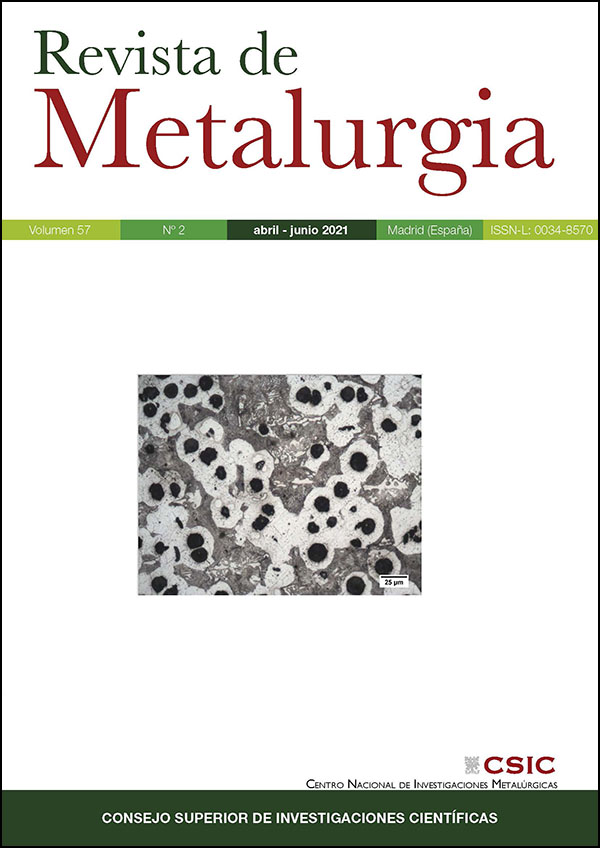Mechanical and microstructural analysis in the welding of ductile cast iron by TIG procedure, with different filler materials and air cooling
DOI:
https://doi.org/10.3989/revmetalm.194Keywords:
Base metal, Interface-weld bead, Ductile cast iron, Repair, TIG weldabilityAbstract
The present work analyses the strength and microstuctural variations of ductile cast iron welded by means of the TIG technique, without heat treatment and using different filler materials (pearlitic malleable cast iron, Fe-Ni alloy and bronze and manganese alloy). The specimens for the mechanical and microstructural tests are obtained from each welded coupon with dimensions 100x 100x6 mm. Based on the qualitative analysis of the micrographs and the quantitative analysis of the results of the mechanical tests, which have been carried out in well-differentiated areas of the welded joints (base metal, interface and weld bead), it is concluded that this type of welding and the introduction of new variables such as the heat treatments before and/or after welding are suitable. The mechanical and strength characteristics have been correlated with the microstructures obtained in the plates (specimens) in order to evaluate their advantages and disadvantages, as well as to draw conclusions.
Downloads
References
Abboud, J.H. (2012). Microstructure and erosion characteristic of nodular cast iron surface modified by tungsten inert gas. Mater. Design 35, 677-684. https://doi.org/10.1016/j.matdes.2011.09.029
Askari-Paykani, M., Shayan, M., Shamanian, M. (2014). Weldability of ferritic ductile cast iron using full factorial design of experiment. J. Iron Steel Res. Int. 21 (2), 252-263. https://doi.org/10.1016/S1006-706X(14)60039-X
Bhatnagar, R.K., Gupta, G. (2016). A Review on Weldability of Cast Iron. IJSER 7 (5), 126-131.
Bhatti, A.A., Barsoum, Z., Murakawa, H., Barsoum, I. (2015). Influence of thermo-mechanical material properties of different steel grades on welding residual stresses and angular distortion. Mater. Design 65, 878-889. https://doi.org/10.1016/j.matdes.2014.10.019
Cárcel-Carrasco, F.J., Pérez-Puig, M.A., Pascual-Guillamón, M., Pascual-Martínez, R. (2016). An analysis of the weldability of ductile cast iron using inconel 625 for the root weld and electrodes coated in 97.6% nickel for the filler welds. Metals 6 (11), 283. https://doi.org/10.3390/met6110283
Cárcel-Carrasco, J., Pascual, M., Pérez-Puig, M., Segovia, F. (2017). Comparative study of TIG and SMAW root welding passes on ductile iron cast weldability. Metalurgija 56 (1-2), 91-93.
Chamim, M., Triyono, Diharjo, K. (2017). Effect of electrode and weld current on the physical and mechanical properties of cast iron welding. AIP Conf. Proc. 1788 (1), 030031. https://doi.org/10.1063/1.4968284
De La Torre, U., Loizaga, A., Lacaze, J., Sertucha, J. (2014). As cast high silicon ductile irons with optimised mechanical properties and remarkable fatigue properties. Mater. Sci. Tech. 30 (12), 1425-1431. https://doi.org/10.1179/1743284713Y.0000000483
Ebrahimnia, M., Ghaini, F.M., Gholizade, S., Salari, M. (2012). Effect of cooling rate and powder characteristics on the soundness of heat affected zone in powder welding of ductile cast iron. Mater. Design 33, 551-556. https://doi.org/10.1016/j.matdes.2011.04.063
El-Banna, E.M. (1999). Effect of preheat on welding of ductile cast iron. Mater. Lett. 41 (1), 20-26. https://doi.org/10.1016/S0167-577X(99)00098-1
Gouveia, R.M., Silva, F.J.G., Paiva, O.C., de Fátima Andrade, M., Pereira, L.A., Moselli, P.C., Papis, K.J.M. (2018). Comparing the structure and mechanical properties of welds on ductile cast iron (700 MPa) under different heat treatment conditions. Metals 8 (1), 72. https://doi.org/10.3390/met8010072
Kumar, R., Kumar, M., Trivedi, V., Bhatnagar, R. (2017). Evaluation of Mechanical and Microstructural Properties of Cast Iron with Effect of Pre Heat and Post Weld Heat Treatment. Int. J. Mech. Eng. 4 (5), 1-6. https://doi.org/10.14445/23488360/IJME-V4I5P101
Marques, E.S.V., Silva, F.J.G., Paiva, O.C., Pereira, A.B. (2019). Improving the mechanical strength of ductile cast iron welded joints using different heat treatments. Materials 12 (14), 2263. https://doi.org/10.3390/ma12142263
Merchant Samir, Y. (2015). A Review of Effect of Welding and Post Weld Heat Treatment on Microstructure and Mechanical Properties of Grade 91 Steel. IJRET 4 (3), 574-580. https://doi.org/10.15623/ijret.2015.0403096
Pascual, M., Ferrer, C., Rayón, E. (2009). Weldability of spheroidal graphite ductile cast iron using Ni / Ni-Fe electrodes. Rev. Metal. 45 (5), 334-338. https://doi.org/10.3989/revmetalm.0814
Sellamuthu, P., Samuel, D.G.H., Dinakaran, D., Premkumar, V.P., Li, Z., Seetharaman, S. (2018). Austempered ductile iron (ADI): Influence of austempering temperature on microstructure, mechanical and wear properties and energy consumption. Metals 8 (1), 53. https://doi.org/10.3390/met8010053
Suárez-Sanabria, A., Fernández-Carrasquilla, J. (2006). Microestructura y propiedades mecánicas de una fundición esferoidal ferrítica en bruto de colada para su uso en piezas de grandes dimensiones. Rev. Metal. 42 (1), 18-31. https://doi.org/10.3989/revmetalm.2006.v42.i1.3
UNE-EN 876 (1996). Ensayos destructivos de uniones soldadas en materiales metálicos. Ensayos de tracción longitudinal sobre el metal de aportación en uniones soldadas por fusión. Normalización Española.
UNE-EN 10002-1 (2002). Materiales metálicos: Ensayos de tracción. Parte 1, Método de ensayo a temperatura ambiente. Asociación Española de Normalización y Certificación.
UNE-EN 1563 (2019). Fundición. Fundición de grafito esferoidal. Normalización Española y Certificación.
Wube Dametew, A. (2015). Experimental investigation on weld ability of cast iron. Science Discovery 3 (6), 71-75. https://doi.org/10.11648/j.sd.20150306.15
Published
How to Cite
Issue
Section
License
Copyright (c) 2021 Consejo Superior de Investigaciones Científicas (CSIC)

This work is licensed under a Creative Commons Attribution 4.0 International License.
© CSIC. Manuscripts published in both the printed and online versions of this Journal are the property of Consejo Superior de Investigaciones Científicas, and quoting this source is a requirement for any partial or full reproduction.
All contents of this electronic edition, except where otherwise noted, are distributed under a “Creative Commons Attribution 4.0 International” (CC BY 4.0) License. You may read the basic information and the legal text of the license. The indication of the CC BY 4.0 License must be expressly stated in this way when necessary.
Self-archiving in repositories, personal webpages or similar, of any version other than the published by the Editor, is not allowed.
















